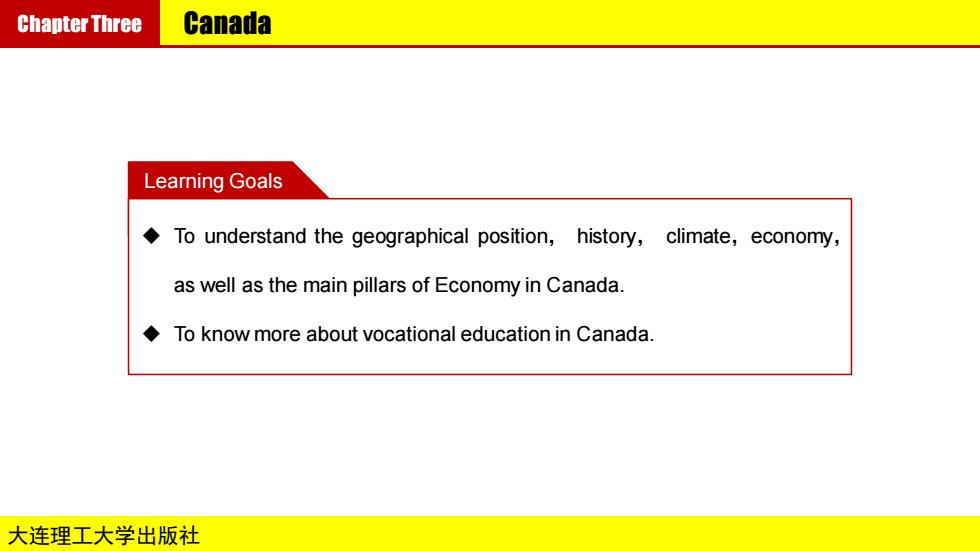
Chapter Three Canada Learning Goals To understand the geographical position,history,climate,economy, as well as the main pillars of Economy in Canada. To know more about vocational education in Canada. 大连理工大学出版社
大连理工大学出版社 Chapter Three Canada Learning Goals ◆ To understand the geographical position, history, climate,economy, as well as the main pillars of Economy in Canada. ◆ To know more about vocational education in Canada
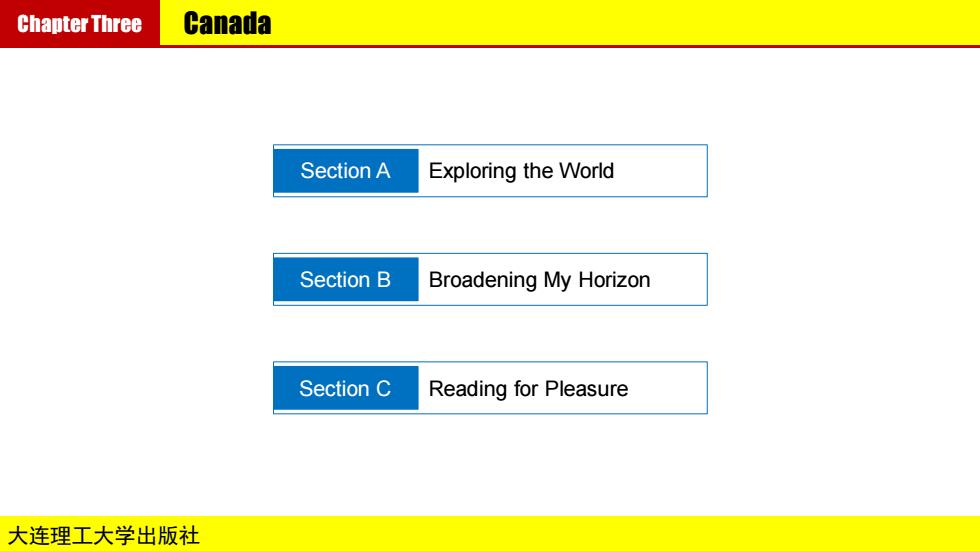
Chapter Three Canada Section A Exploring the World Section B Broadening My Horizon Section C Reading for Pleasure 大连理工大学出版社
大连理工大学出版社 Chapter Three Canada Section A Exploring the World Section B Broadening My Horizon Section C Reading for Pleasure
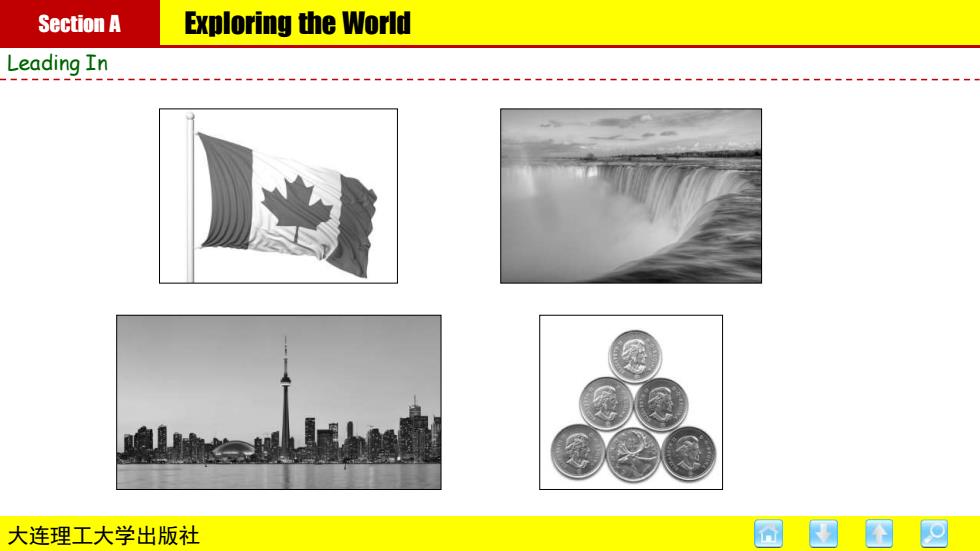
Section A Exploring the World Leading In 大连理工大学出版社 圈团①四
大连理工大学出版社 Section A Exploring the World Leading In
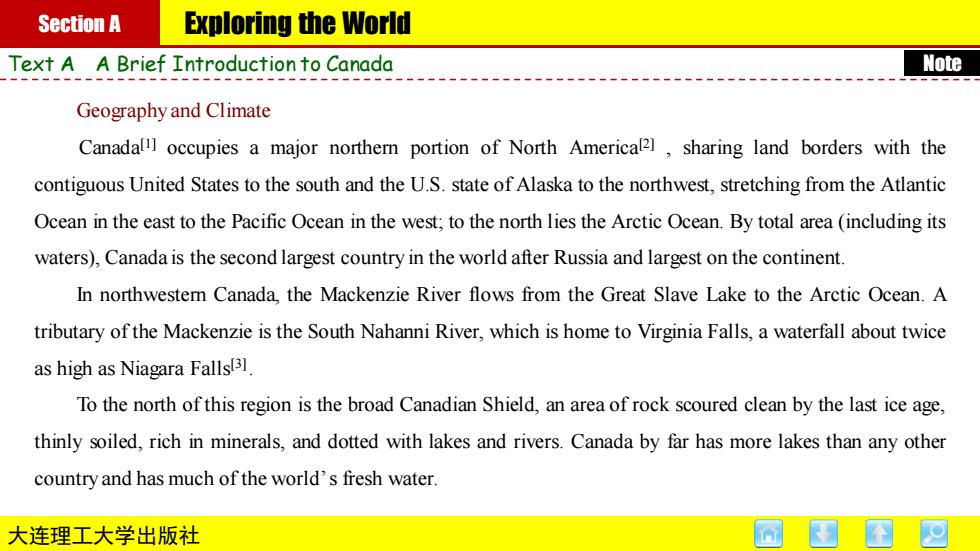
Section A Exploring the World Text AA Brief Introduction to Canada Note Geography and Climate Canadalll occupies a major northem portion of North Americal21,sharing land borders with the contiguous United States to the south and the U.S.state of Alaska to the northwest,stretching from the Atlantic Ocean in the east to the Pacific Ocean in the west;to the north lies the Arctic Ocean.By total area(including its waters),Canada is the second largest country in the world after Russia and largest on the continent. In northwestemn Canada,the Mackenzie River flows from the Great Slave Lake to the Arctic Ocean.A tributary of the Mackenzie is the South Nahanni River,which is home to Virginia Falls,a waterfall about twice as high as Niagara Falls31. To the north of this region is the broad Canadian Shield,an area of rock scoured clean by the last ice age, thinly soiled,rich in minerals,and dotted with lakes and rivers.Canada by far has more lakes than any other country and has much of the world's fresh water. 大连理工大学出版社
大连理工大学出版社 Section A Exploring the World Text A A Brief Introduction to Canada Geography and Climate Canada[1] occupies a major northern portion of North America[2] , sharing land borders with the contiguous United States to the south and the U.S. state of Alaska to the northwest, stretching from the Atlantic Ocean in the east to the Pacific Ocean in the west; to the north lies the Arctic Ocean. By total area (including its waters), Canada is the second largest country in the world after Russia and largest on the continent. In northwestern Canada, the Mackenzie River flows from the Great Slave Lake to the Arctic Ocean. A tributary of the Mackenzie is the South Nahanni River, which is home to Virginia Falls, a waterfall about twice as high as Niagara Falls[3] . To the north of this region is the broad Canadian Shield, an area of rock scoured clean by the last ice age, thinly soiled, rich in minerals, and dotted with lakes and rivers. Canada by far has more lakes than any other country and has much of the world’s fresh water. Note

Section A Exploring the World Text AA Brief Introduction to Canada Political System A federation comprising ten provinces and three territories,Canada is a parliamentary democracy and a constitutional monarchy,with Queen Elizabeth II as its head of state.It is a bilingual and multicultural country, with both English and French as official languages both at the federal level and in the province of New Brunswick. Technologically advanced and industrialized,Canada maintains a diversified economy that is heavily reliant upon its abundant natural resources and upon trade-particularly with the United States,with which Canada has had a long and complex relationship. The provinces are responsible for most of Canada's social programs(such as health care,education,and welfare)and together collect more revenue than the federal government,an almost unique structure among federations in the world.Using its spending powers,the federal government can initiate national policies in provincial areas,such as the Canada Health Act,the provinces can opt out of these,but rarely do so in practice. Equalization payments are made by the federal government to ensure that reasonably uniform standards of services and taxation are kept between the richer and poorer provinces. 大连理工大学出版社
大连理工大学出版社 Section A Exploring the World Text A A Brief Introduction to Canada Political System A federation comprising ten provinces and three territories, Canada is a parliamentary democracy and a constitutional monarchy, with Queen Elizabeth II as its head of state. It is a bilingual and multicultural country, with both English and French as official languages both at the federal level and in the province of New Brunswick. Technologically advanced and industrialized, Canada maintains a diversified economy that is heavily reliant upon its abundant natural resources and upon trade — particularly with the United States, with which Canada has had a long and complex relationship. The provinces are responsible for most of Canada’s social programs (such as health care, education, and welfare) and together collect more revenue than the federal government, an almost unique structure among federations in the world. Using its spending powers, the federal government can initiate national policies in provincial areas, such as the Canada Health Act; the provinces can opt out of these, but rarely do so in practice. Equalization payments are made by the federal government to ensure that reasonably uniform standards of services and taxation are kept between the richer and poorer provinces
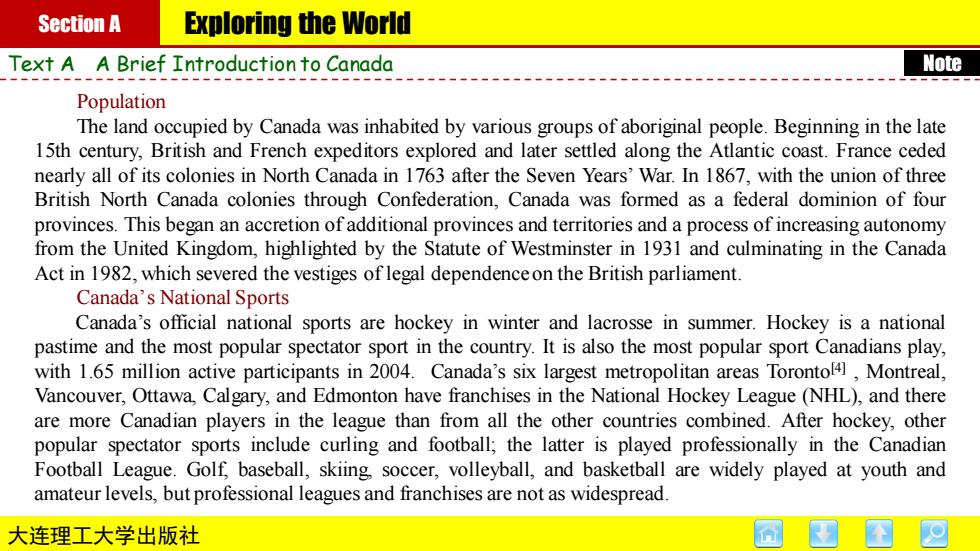
Section A Exploring the World Text AA Brief Introduction to Canada Note Population The land occupied by Canada was inhabited by various groups of aboriginal people.Beginning in the late 15th century,British and French expeditors explored and later settled along the Atlantic coast.France ceded nearly all of its colonies in North Canada in 1763 after the Seven Years'War.In 1867,with the union of three British North Canada colonies through Confederation,Canada was formed as a federal dominion of four provinces.This began an accretion of additional provinces and territories and a process of increasing autonomy from the United Kingdom,highlighted by the Statute of Westminster in 1931 and culminating in the Canada Act in 1982,which severed the vestiges of legal dependenceon the British parliament. Canada's National Sports Canada's official national sports are hockey in winter and lacrosse in summer.Hockey is a national pastime and the most popular spectator sport in the country.It is also the most popular sport Canadians play, with 1.65 million active participants in 2004.Canada's six largest metropolitan areas Torontol4l,Montreal, Vancouver,Ottawa,Calgary,and Edmonton have franchises in the National Hockey League(NHL),and there are more Canadian players in the league than from all the other countries combined.After hockey,other popular spectator sports include curling and football;the latter is played professionally in the Canadian Football League.Golf,baseball,skiing soccer,volleyball,and basketball are widely played at youth and amateur levels,but professional leagues and franchises are not as widespread. 大连理工大学出版社
大连理工大学出版社 Section A Exploring the World Text A A Brief Introduction to Canada Population The land occupied by Canada was inhabited by various groups of aboriginal people. Beginning in the late 15th century, British and French expeditors explored and later settled along the Atlantic coast. France ceded nearly all of its colonies in North Canada in 1763 after the Seven Years’ War. In 1867, with the union of three British North Canada colonies through Confederation, Canada was formed as a federal dominion of four provinces. This began an accretion of additional provinces and territories and a process of increasing autonomy from the United Kingdom, highlighted by the Statute of Westminster in 1931 and culminating in the Canada Act in 1982, which severed the vestiges of legal dependenceon the British parliament. Canada’s National Sports Canada’s official national sports are hockey in winter and lacrosse in summer. Hockey is a national pastime and the most popular spectator sport in the country. It is also the most popular sport Canadians play, with 1.65 million active participants in 2004. Canada’s six largest metropolitan areas Toronto[4] , Montreal, Vancouver, Ottawa, Calgary, and Edmonton have franchises in the National Hockey League (NHL), and there are more Canadian players in the league than from all the other countries combined. After hockey, other popular spectator sports include curling and football; the latter is played professionally in the Canadian Football League. Golf, baseball, skiing, soccer, volleyball, and basketball are widely played at youth and amateur levels, but professional leagues and franchises are not as widespread. Note

Section A Exploring the World Text AA Brief Introduction to Canada Canada hosted several high-profile intemnational sporting events,including the 1976 Summer Olympics, the 1988 Winter Olympics,2010 Winter Olympics,and the 2007 FIFA U-20 World Cup. 大连理工大学出版社 圈团①四
大连理工大学出版社 Section A Exploring the World Text A A Brief Introduction to Canada Canada hosted several high-profile international sporting events, including the 1976 Summer Olympics, the 1988 Winter Olympics, 2010 Winter Olympics, and the 2007 FIFA U-20 World Cup
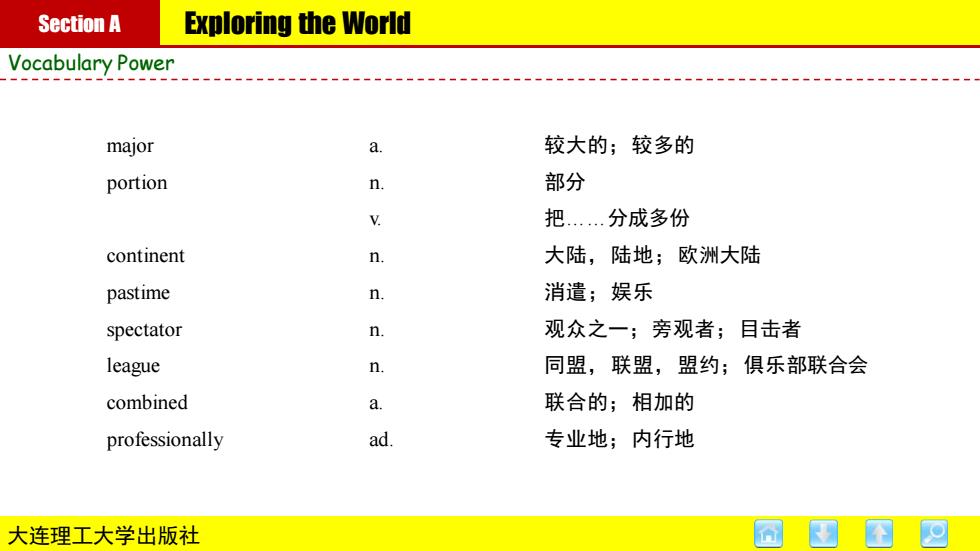
Section A Exploring the World Vocabulary Power major a. 较大的;较多的 portion n. 部分 V 把..…分成多份 continent n. 大陆,陆地;欧洲大陆 pastime n. 消遣;娱乐 spectator n 观众之一;旁观者;目击者 league n. 同盟,联盟,盟约;俱乐部联合会 combined 联合的;相加的 professionally ad. 专业地;内行地 大连理工大学出版社
大连理工大学出版社 Section A Exploring the World Vocabulary Power major a. 较大的;较多的 portion n. 部分 v. 把……分成多份 continent n. 大陆,陆地;欧洲大陆 pastime n. 消遣;娱乐 spectator n. 观众之一;旁观者;目击者 league n. 同盟,联盟,盟约;俱乐部联合会 combined a. 联合的;相加的 professionally ad. 专业地;内行地
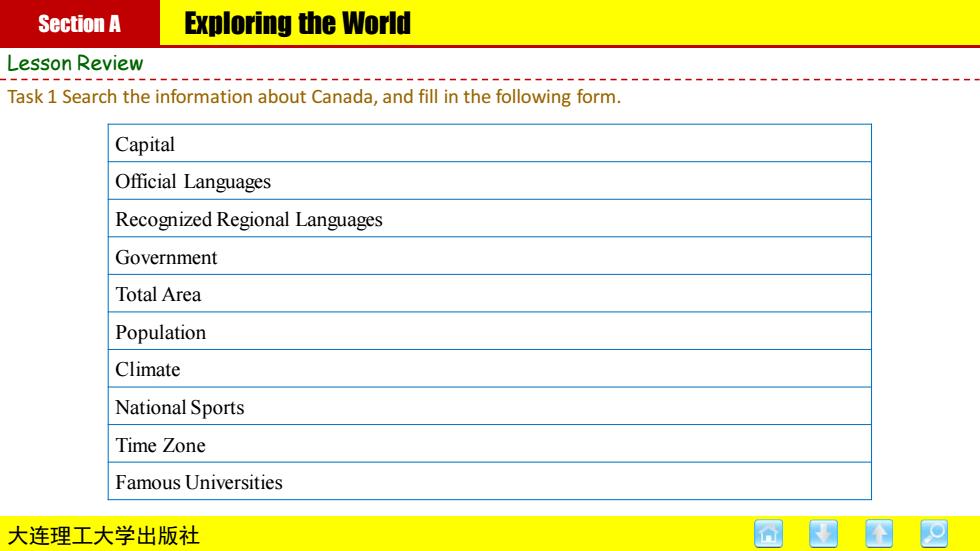
Section A Exploring the World Lesson Review Task 1 Search the information about Canada,and fill in the following form. Capital Official Languages Recognized Regional Languages Government Total Area Population Climate National Sports Time Zone Famous Universities 大连理工大学出版社 固团图四
大连理工大学出版社 Section A Exploring the World Lesson Review Task 1 Search the information about Canada, and fill in the following form. Capital Official Languages Recognized Regional Languages Government Total Area Population Climate National Sports Time Zone Famous Universities
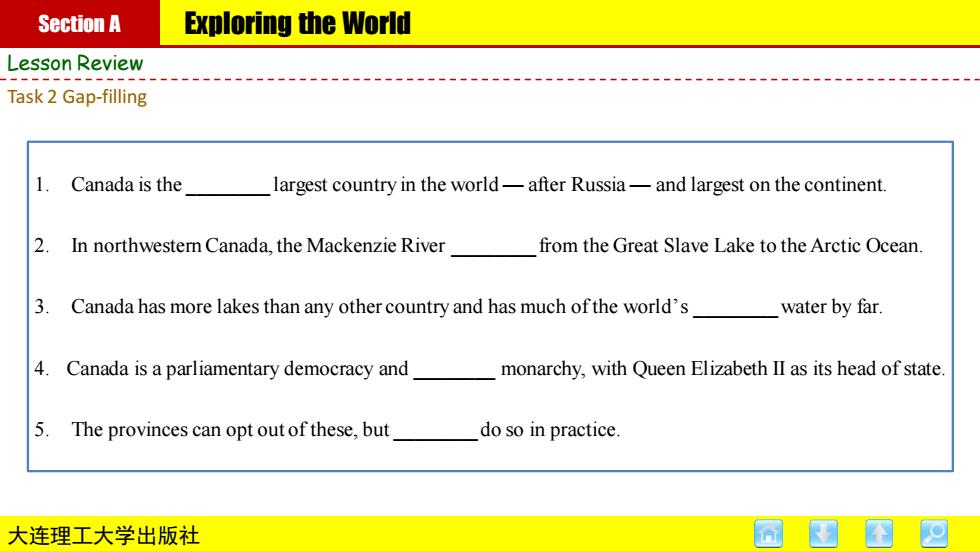
Section A Exploring the World Lesson Review Task 2 Gap-filling 1. Canada is the largest country in the world-after Russia-and largest on the continent. 2.In northwestern Canada.the Mackenzie River from the Great Slave Lake to the Arctic Ocean. 3. Canada has more lakes than any other country and has much ofthe world's water by far. 4.Canada is a parliamentary democracy and monarchy,with Queen Elizabeth II as its head of state. 5.The provinces can opt out of these,but do so in practice. 大连理工大学出版社
大连理工大学出版社 Section A Exploring the World Lesson Review Task 2 Gap-filling 1. Canada is the ________ largest country in the world — after Russia — and largest on the continent. 2. In northwestern Canada, the Mackenzie River ________ from the Great Slave Lake to the Arctic Ocean. 3. Canada has more lakes than any other country and has much of the world’ s ________ water by far. 4. Canada is a parliamentary democracy and ________ monarchy, with Queen Elizabeth II as its head of state. 5. The provinces can opt out of these, but ________ do so in practice